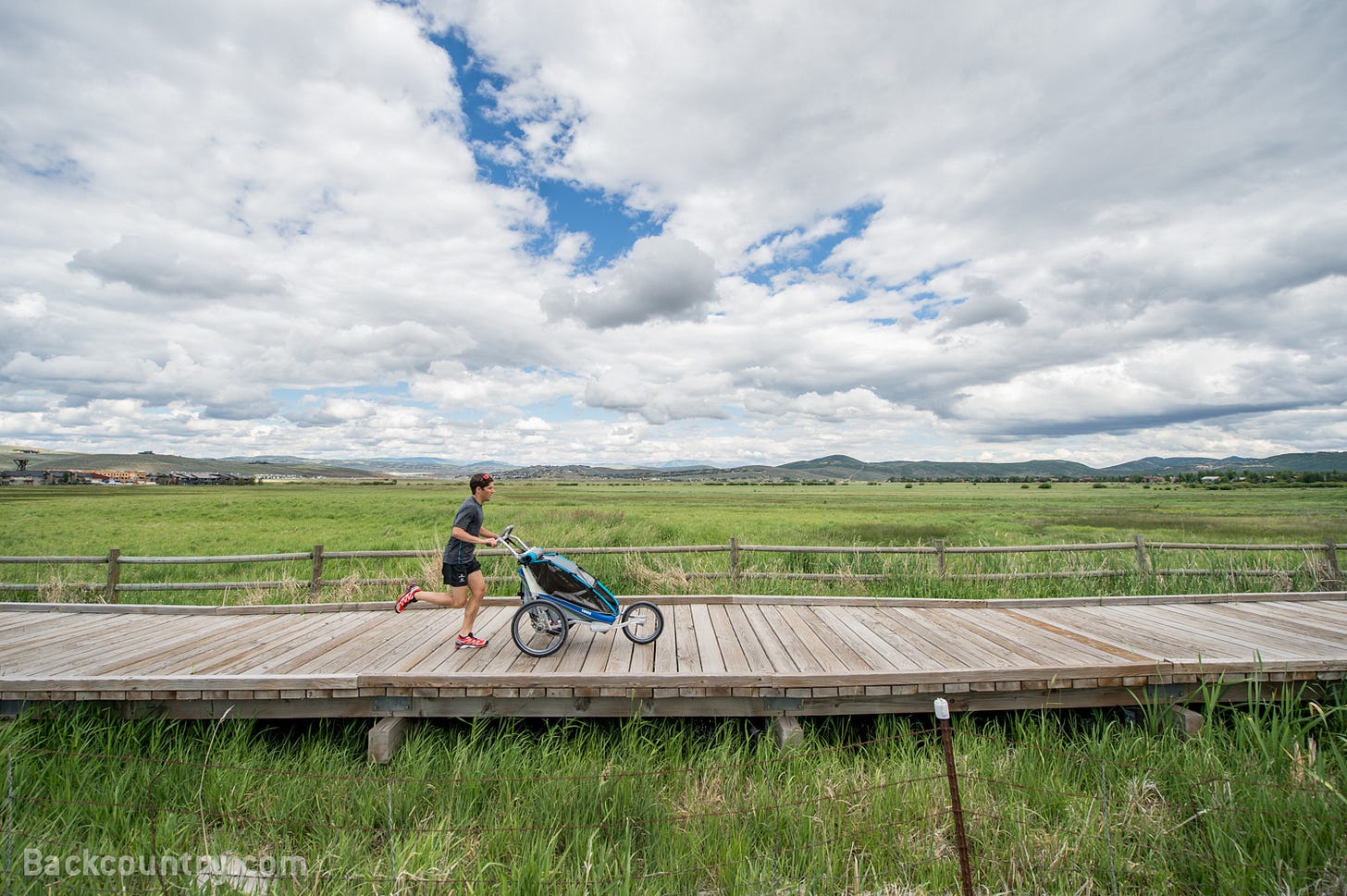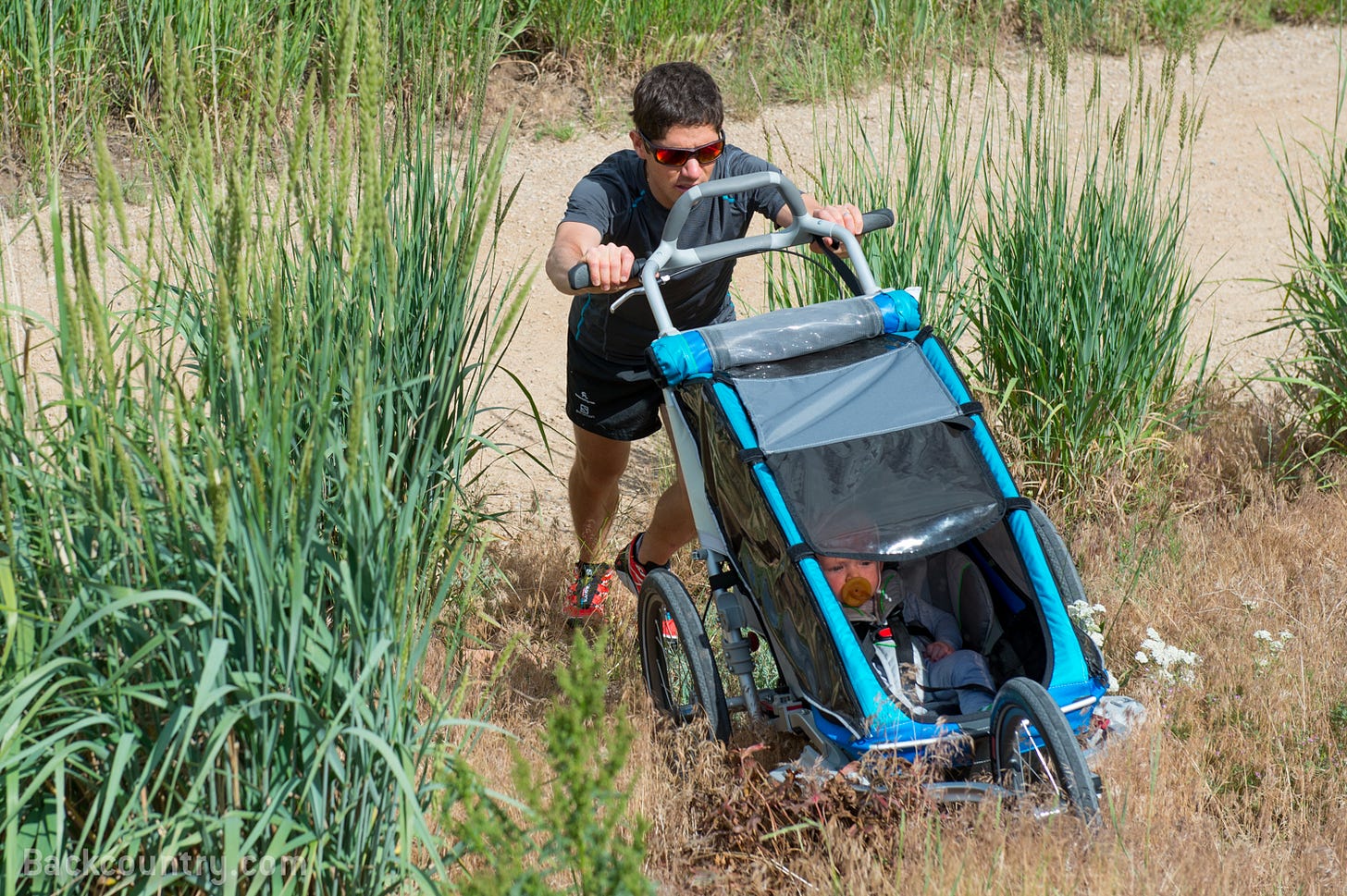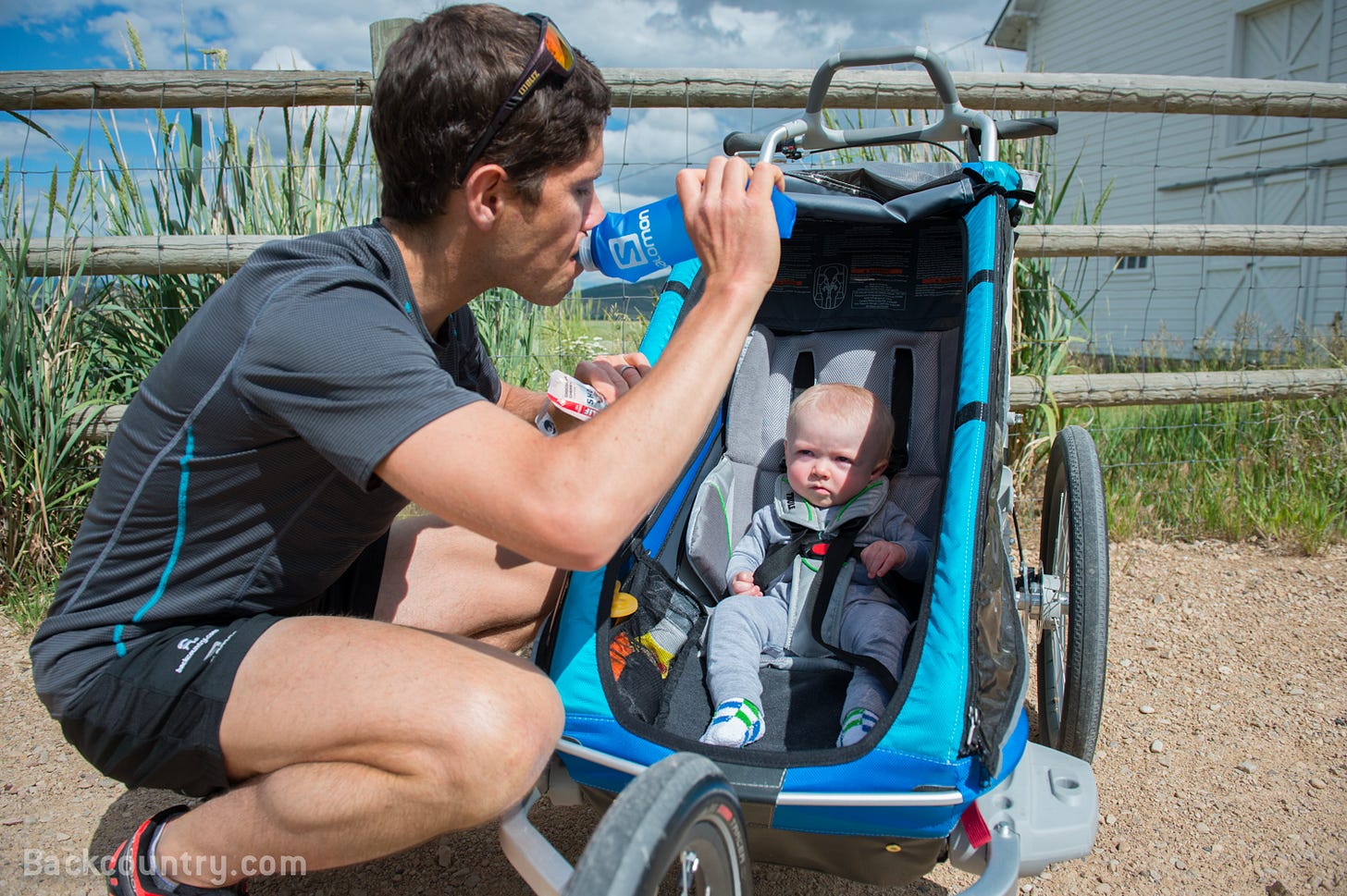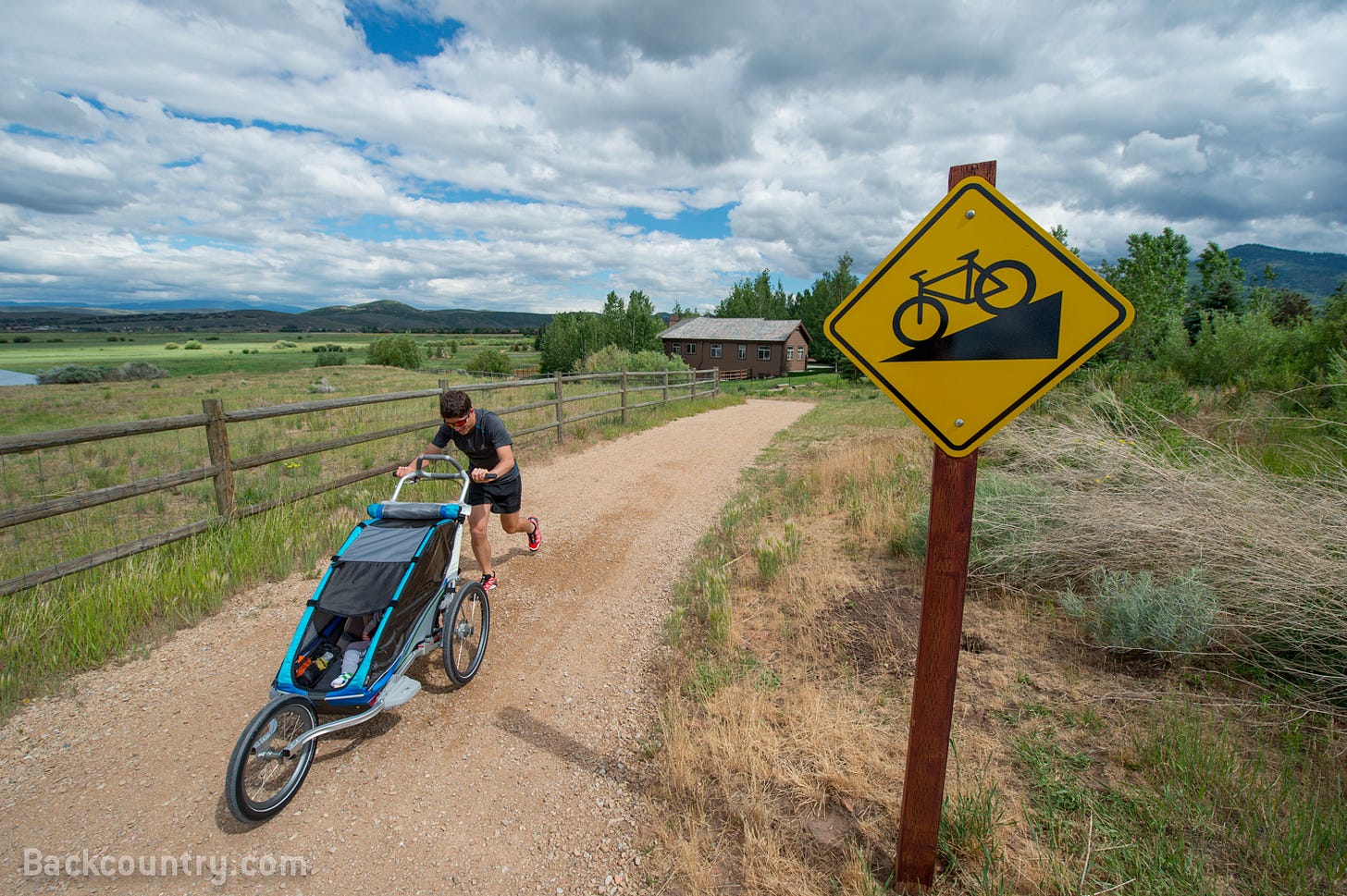Do's and Don'ts of Stroller Running
From the Archives
The day my Thule Chariot CX1 jogging stroller was delivered to the door, the first thought that came to my head was “freedom.” No, not the kind of freedom you feel when you are wearing nothing but a bathrobe. I’m speaking about the kind of freedom John Steinbeck writes about in his travelogue Travels with Charley: In Search of America, his account of a 1960 road trip around the United States with his French standard poodle, Charley. In it, he describes the freedom to explore and learn about your surroundings, the freedom to travel the open road and choose your own path, and the freedom to share this journey with a faithful companion. My newfound freedom with the CX1 jogging stroller wasn’t a do-before-you-die voyage across the U.S. in a van with a furry friend, but it did mean I could explore Salt Lake City--on or off the beaten path--with Lou, my son and trusty companion.
And it’s not just about getting out of the house--I’ll be the first to admit (and my wife will be the first to complain!) that I can get antsy and cabin fever-ish when I don’t run or exercise. As a competitive athlete, full-time Marketing Analyst, and father, being able to multi-task is not only helpful, it’s imperative. In addition, the ability to share time with my boy, get running miles in my legs, and give my wife a break has helped me in countless ways. Not to mention, it can be fun!
If you already own a jogging stroller or if you are thinking about purchasing one, I’d like to share with you a few “Dos” and “Don’ts” so that you too can enjoy the pleasures of baby jogging, and pass along a few tips for getting in a good workout.
THE BASICS
Errands
Do use your baby jogger as a way to combine exercise and doing errands
Don’t forget you have to bring whatever you purchase home with you in the stroller
While a baby jogger can be used for exercise of nearly any intensity, I also like to use my CX1 to do errands by foot. I take my son and jogger to the grocery store, farmers’ market, hardware store, and post office. One of the key features of Thule’s Chariot CX1 is that it doubles as a shopping cart with adequate storage capacity, boasting one cargo bag on the lower back, one large mesh pocket on the upper back, one small pocket inside large mesh pocket, and two small mesh pockets inside the carrier at the front. (Note that the maximum load capacity of the larger cargo bag is 8.8 pounds.) For reference, a gallon of 2% milk weighs just about that. So be sure to monitor the weight and size of your purchases, and don’t forget you have to tow home whatever you buy. Your baby may not be too excited about sharing space with a lot of produce!
Going Off-Road
Do take the Chariot off road
Don’t take the Chariot too far off the beaten path
As a trail runner, I love the solitude of running on trails. To me, there’s nothing better than an early morning run on quiet, traffic-free trails just as the sun peeks into a dewy meadow and illuminates a herd of deer noshing on breakfast. It becomes more rewarding when you can share those experiences with your children. With disc brakes for better braking control, ergonomic and adjustable handlebars, and a suspension that you can set to the weight of your child, the CX1 is well-suited to travel over hard packed gravel and smooth trails without a problem. But do note: even though most joggers feature an anodized aluminum roll cage, for the safety of your precious cargo, I’d advise you to not go too far off the beaten path. And always make sure that your child is strapped in with the five-point harness, even if he or she is having none of it that day.
Fuel
Do bring snacks and hydration
Don’t bring snacks and hydration only for you
Before I started sharing my training time with Lou, going out for a long run or interval session was simple and, dare I say, selfishly focused on my needs. When I go out for a long run, for instance, I always make sure to carry a water bottle with Lemon-Lime Skratch Labs and, though I don’t like the texture of energy gels, I take an emergency Clif Shot, in case I need supplemental calories to make the run less of a slog and more enjoyable. Similarly, when out baby jogging with your child, a happy baby makes a happy passenger, which translates to an enjoyable ride for the baby and an enjoyable run for you. In case you forgot, babies require a lot of attention. As in, they can’t change their own diapers and they certainly can’t remember to bring their own provisions on an outing with Mom or Dad. I bring along emergency snacks as well as toys for my son, in case he gets hungry or bored. So, if you head out for a long run in the Thule Chariot CX1, do remember to bring snacks and hydration. But remember, baby jogging requires greater attention to all things baby related and it’s no longer just about you, so don’t bring provisions just for you to make it through the long run. Trust me.
Safety
Do obey the rules of the road (SERIOUSLY)
Don’t expect automobiles or cyclists or other pedestrians to be aware of you
Your first concern when baby jogging should be about safety. Seriously. It is important that all of you current and future baby jogger enthusiasts to obey the rules of the road, for your and your child’s safety and the safety of others on the road. When you and your child are out exploring, it is imperative you are attentive and you remember that it is dangerous to jaywalk, roll through stop signs and crosswalks, and ignore rights of way, especially when you’re pushing or towing the additional girth and weight of a jogging stroller. The CX1, like most joggers, comes in conspicuous colors and is equipped with reflective material to be better seen by vehicles at dawn or dusk. Still, don’t expect automobiles, cyclists, or other pedestrians to be aware of you and your jogger. So please, please, please look both ways before crossing and be extra aware of your surroundings.
GETTING A WORKOUT
Excursions with a baby jogger can be more than just getting out and about. Now that we have some of the basics covered, here are some tips for getting a serious workout with your jogger.
Expect to go slower
When I first took the stroller out for a run, I immediately noticed the level of effort to run while pushing was more difficult. My typical five-mile loop took me about 20 percent longer to finish than without a stroller. Although your strength and expertise with running while pushing a stroller will improve over time, babies keep getting bigger and gaining more weight (making the stroller heavier to push), so it’s sometimes frustrating to look at the numbers. Two things to keep in mind are you're burning more calories with your effort and doing some resistance training, so don't worry about the slower pace.
Foot plant
When running uphill while pushing the stroller, I sometimes catch myself planting my foot with toes outward, as if I am doing the fishbone while skiing uphill. I make an effort to keep my toes forward so that I plant my foot as I would without a stroller. It is hard enough on your body to run while pushing extra weight (my arms were sore the first few weeks!), so be mindful of foot positioning so that you don’t find yourself injured on the sidelines.
Running hands-free is unsafe
It’s not a good idea, even if it helps you achieve a more natural arm swing. The stroller could easily lose control and get away from you, which is unsafe for your child and anyone else around you.
Push with one hand instead
Pushing a jogging stroller impedes your natural arm swing, which makes it much tougher on your lungs, heart, and legs. So try pushing the stroller with one arm and swinging with the other. Keep switching arms so you get to work both sides. If you do opt for the one-handed push, make certain the leash is around the pushing arm so that you minimize the risk of inadvertently losing control of the stroller.
Patience makes progress
I run with Lou almost every day – taking him on recovery jogs, interval sessions (I call them “strollervals”), and long runs. But, because of the increased effort required to run while pushing a jogging stroller, I didn’t start out running that frequently or intensely. For instance, I built up my long run over several weeks’ time by adding five minutes to my run every Sunday. My first long run was approximately an hour and I’ve built up to 1 hour 45 minutes, comfortably, over the course of three months.







